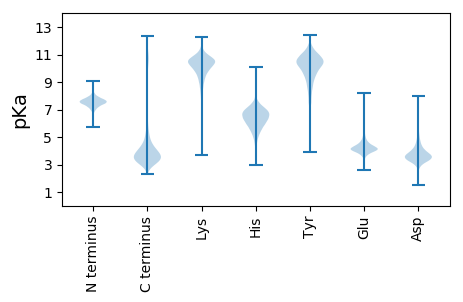
Penicillium polonicum
Taxonomy: cellular organisms; Eukaryota; Opisthokonta; Fungi; Dikarya; Ascomycota; saccharomyceta; Pezizomycotina; leotiomyceta;
Average proteome isoelectric point is 6.3
Get precalculated fractions of proteins

Virtual 2D-PAGE plot for 10627 proteins (isoelectric point calculated using IPC2_protein)
Get csv file with sequences according to given criteria:
* You can choose from 21 different methods for calculating isoelectric point
Summary statistics related to proteome-wise predictions



Protein with the lowest isoelectric point:
>tr|A0A1V6N734|A0A1V6N734_9EURO Uncharacterized protein OS=Penicillium polonicum OX=60169 GN=PENPOL_c023G07513 PE=4 SV=1
MM1 pKa = 7.95RR2 pKa = 11.84VQQLLPLCGLLLTSVAIASKK22 pKa = 10.68LDD24 pKa = 3.54NDD26 pKa = 4.87DD27 pKa = 3.41VPNRR31 pKa = 11.84CWPACGPVVGIAKK44 pKa = 10.16SCDD47 pKa = 3.49DD48 pKa = 3.24QHH50 pKa = 6.87EE51 pKa = 4.38RR52 pKa = 11.84DD53 pKa = 3.76SSEE56 pKa = 3.82IQCICNWDD64 pKa = 3.5AAKK67 pKa = 8.97TQIPLCSACITQYY80 pKa = 9.2QTDD83 pKa = 3.85KK84 pKa = 10.48RR85 pKa = 11.84NHH87 pKa = 6.59NITHH91 pKa = 6.89NDD93 pKa = 3.42HH94 pKa = 7.7DD95 pKa = 6.23DD96 pKa = 5.2DD97 pKa = 7.63DD98 pKa = 7.37DD99 pKa = 7.69DD100 pKa = 7.66DD101 pKa = 7.62DD102 pKa = 7.63DD103 pKa = 7.63DD104 pKa = 7.57DD105 pKa = 6.61DD106 pKa = 6.6DD107 pKa = 6.14NEE109 pKa = 4.5ALDD112 pKa = 4.81LVHH115 pKa = 6.72SCSLTTTTYY124 pKa = 10.82NPAATSVTGTSTTTAGSNTATTTGTSSTTTSNGASGTNSQDD165 pKa = 3.15STSSVSSGSSNLASASSGSASSSNPTPDD193 pKa = 3.0AAAGISAPGAASMAGVMGLMAFAWLL218 pKa = 3.69
MM1 pKa = 7.95RR2 pKa = 11.84VQQLLPLCGLLLTSVAIASKK22 pKa = 10.68LDD24 pKa = 3.54NDD26 pKa = 4.87DD27 pKa = 3.41VPNRR31 pKa = 11.84CWPACGPVVGIAKK44 pKa = 10.16SCDD47 pKa = 3.49DD48 pKa = 3.24QHH50 pKa = 6.87EE51 pKa = 4.38RR52 pKa = 11.84DD53 pKa = 3.76SSEE56 pKa = 3.82IQCICNWDD64 pKa = 3.5AAKK67 pKa = 8.97TQIPLCSACITQYY80 pKa = 9.2QTDD83 pKa = 3.85KK84 pKa = 10.48RR85 pKa = 11.84NHH87 pKa = 6.59NITHH91 pKa = 6.89NDD93 pKa = 3.42HH94 pKa = 7.7DD95 pKa = 6.23DD96 pKa = 5.2DD97 pKa = 7.63DD98 pKa = 7.37DD99 pKa = 7.69DD100 pKa = 7.66DD101 pKa = 7.62DD102 pKa = 7.63DD103 pKa = 7.63DD104 pKa = 7.57DD105 pKa = 6.61DD106 pKa = 6.6DD107 pKa = 6.14NEE109 pKa = 4.5ALDD112 pKa = 4.81LVHH115 pKa = 6.72SCSLTTTTYY124 pKa = 10.82NPAATSVTGTSTTTAGSNTATTTGTSSTTTSNGASGTNSQDD165 pKa = 3.15STSSVSSGSSNLASASSGSASSSNPTPDD193 pKa = 3.0AAAGISAPGAASMAGVMGLMAFAWLL218 pKa = 3.69
Molecular weight: 22.35 kDa
Isoelectric point according different methods:
Protein with the highest isoelectric point:
>tr|A0A1V6NUI8|A0A1V6NUI8_9EURO Uncharacterized protein OS=Penicillium polonicum OX=60169 GN=PENPOL_c003G05735 PE=3 SV=1
MM1 pKa = 7.89PSNKK5 pKa = 8.19TFRR8 pKa = 11.84TKK10 pKa = 10.49QKK12 pKa = 9.65LAKK15 pKa = 9.74AQRR18 pKa = 11.84QNRR21 pKa = 11.84PIPQWIRR28 pKa = 11.84LRR30 pKa = 11.84TGNTIRR36 pKa = 4.53
MM1 pKa = 7.89PSNKK5 pKa = 8.19TFRR8 pKa = 11.84TKK10 pKa = 10.49QKK12 pKa = 9.65LAKK15 pKa = 9.74AQRR18 pKa = 11.84QNRR21 pKa = 11.84PIPQWIRR28 pKa = 11.84LRR30 pKa = 11.84TGNTIRR36 pKa = 4.53
Molecular weight: 4.34 kDa
Isoelectric point according different methods:
Peptides (in silico digests for buttom-up proteomics)
Below you can find in silico digests of the whole proteome with Trypsin, Chymotrypsin, Trypsin+LysC, LysN, ArgC proteases suitable for different mass spec machines.| Try ESI |
 |
|---|
| ChTry ESI |
 |
|---|
| ArgC ESI |
 |
|---|
| LysN ESI |
 |
|---|
| TryLysC ESI |
 |
|---|
| Try MALDI |
 |
|---|
| ChTry MALDI |
 |
|---|
| ArgC MALDI |
 |
|---|
| LysN MALDI |
 |
|---|
| TryLysC MALDI |
 |
|---|
| Try LTQ |
 |
|---|
| ChTry LTQ |
 |
|---|
| ArgC LTQ |
 |
|---|
| LysN LTQ |
 |
|---|
| TryLysC LTQ |
 |
|---|
| Try MSlow |
 |
|---|
| ChTry MSlow |
 |
|---|
| ArgC MSlow |
 |
|---|
| LysN MSlow |
 |
|---|
| TryLysC MSlow |
 |
|---|
| Try MShigh |
 |
|---|
| ChTry MShigh |
 |
|---|
| ArgC MShigh |
 |
|---|
| LysN MShigh |
 |
|---|
| TryLysC MShigh |
 |
|---|
General Statistics
Number of major isoforms |
Number of additional isoforms |
Number of all proteins |
Number of amino acids |
Min. Seq. Length |
Max. Seq. Length |
Avg. Seq. Length |
Avg. Mol. Weight |
|---|---|---|---|---|---|---|---|
0 |
5256275 |
8 |
6527 |
494.6 |
54.77 |
Amino acid frequency
Ala |
Cys |
Asp |
Glu |
Phe |
Gly |
His |
Ile |
Lys |
Leu |
|---|---|---|---|---|---|---|---|---|---|
8.406 ± 0.02 | 1.246 ± 0.008 |
5.651 ± 0.016 | 6.093 ± 0.026 |
3.83 ± 0.015 | 6.772 ± 0.019 |
2.44 ± 0.01 | 5.148 ± 0.018 |
4.596 ± 0.019 | 9.019 ± 0.024 |
Met |
Asn |
Gln |
Pro |
Arg |
Ser |
Thr |
Val |
Trp |
Tyr |
|---|---|---|---|---|---|---|---|---|---|
2.263 ± 0.008 | 3.743 ± 0.012 |
6.047 ± 0.03 | 4.055 ± 0.015 |
5.879 ± 0.019 | 8.348 ± 0.024 |
6.024 ± 0.014 | 6.143 ± 0.018 |
1.495 ± 0.009 | 2.8 ± 0.012 |
Most of the basic statistics you can see at this page can be downloaded from this CSV file
Proteome-pI is available under Creative Commons Attribution-NoDerivs license, for more details see here
| Reference: Kozlowski LP. Proteome-pI 2.0: Proteome Isoelectric Point Database Update. Nucleic Acids Res. 2021, doi: 10.1093/nar/gkab944 | Contact: Lukasz P. Kozlowski |
